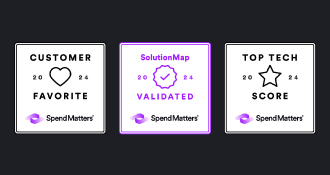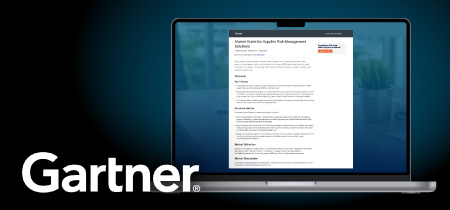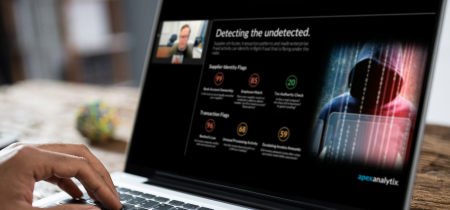In her nearly-twenty-year AP career at Verizon, Lisa Espenshade, Associate Director of AP, has been through more than thirty acquisitions, multiple organizational restructurings, a major finance transformation, a large-scale ERP conversion, and the birth of Verizon Global Services. She has supported an AP strategy including the launch of an E-invoicing solution, supplier discount programs, an automated T&E system, consolidation of ERPs, a corporate card program, and a suite of best practices in partnership with apexanalytix.
Lisa was a featured speaker at the Icon 2023 conference in Miami, Florida, where she talked about her roadmap for best-in-class AP and shared services. Her best practice journey started with an electronic focus, recovery audit, ERP consolidation, digital solutions, building a controls framework, and continues with a mission to achieve ultimate supplier management. The destination? Touchless AP, resource efficiency, exception reduction, and a system of best-in-class controls.
Recovery Audit – Distinct from Traditional Financial Audits
In 2023 alone, Verizon recovered $5.5 million in overpayments due to duplicate payment of invoices and $33.5 million in previously unidentified statement credits. For a company the size of Verizon, with spend of nearly $100 billion annually, a recovery audit is a valuable mitigating control, one the company has had in place since 2002. Even with recoveries in the millions, Verizon is at a best-in-class level of payment accuracy, with recoveries at just 02% of spend.
“As we continue our current large-scale ERP conversion, consolidating ERPs to reduce complexity and lower cost, we still want to maintain a high level of accuracy in our processes. Recovery audits are critical when there is a major change like this. Besides the recoveries themselves, we get supporting reporting that shows where our controls need to be shored up. And, by having this process and reporting over multiple years, we now have benchmarks which help us set goals,” says Lisa
In fact, apexanalytix benchmarking reports that 80% of companies conduct an audit, not solely for the cash, but for the insights to improve operations: analysis of root causes of problems; cross-functional-corrective action workshops with procurement, finance, even corporate investigations; recommendations to improve controls, and identification of “problematic” processes and suppliers.
The recent benchmarking survey uncovered a significant finding related to gaps between recovery audits based on an analysis of audits representing $4.5 trillion in spend. Statement and duplicate recoveries are reduced by 23% for each year an organization delays an audit after the first recovery audit.
Yes, But What Exactly is a Recovery Audit?
You might call it the biggest bang you can get for no bucks. A recovery audit is funded through the proceeds of the audit itself; providers earn a percentage of the amounts recovered. Therefore, no budget is required. The primary goal of a recovery audit is to recover funds that may have been lost due to errors, duplicate payments, pricing discrepancies, unclaimed credits, or other financial irregularities. It helps organizations improve their financial accuracy, reduce financial leakage, and enhance their overall financial performance. The recovery audit process typically involves the following steps:
- Data Collection: Gathering relevant financial data, such as invoices, payment records, and vendor contracts.
- Data Analysis: Utilizing specialized software and techniques to analyze the data and identify potential discrepancies or errors.
- Investigation: Conducting in-depth investigations to validate and confirm the identified discrepancies. This may involve communication with vendors, reviewing contracts, and examining supporting documentation.
- Recovery: Recovering identified overpayments or underpayments by contacting vendors, negotiating settlements, or adjusting future payments.
- Reporting: Providing detailed reports to the organization’s management, highlighting the findings, recovered amounts, and recommendations to improve financial processes and prevent future discrepancies.
Replacing Duplicate Recoveries with Prevention Technology
After a few years of perfecting the duplicate analysis algorithms used by its auditors, apexanalytix began offering its duplicate solution for use in daily business operations to prevent overpayments. Verizon began using the solution, firststrike®, in 2006. In 2023, firststrike stopped 317 duplicates, valued at $380 million, from being paid by Verizon. “With the firststrike tool, we are able to prevent millions in incorrect payments each year.”
The software takes in transactional data from all ERP and other payment systems, conducts AI-driven analysis, applies false positive intelligence, and flags likely duplicate payments and other payment errors. The algorithms used in firststrike undergo continuous fine-tuning by both apexanalytix auditors and the clients who have firststrike implemented to capture and prevent more overpayments over time (across all clients, this averages $2M in payment errors prevented/$1B in spend).
The Road to Best-In-Class Supplier Management
“You can imagine the complexity that is added to the payment process when there is an acquisition,” says Lisa. “As the vendor master grows, there is always the risk of duplication of vendor records which can lead to duplicate payments.”
“Our goal is efficient use of resources. With added vendors and the disruption of business changes, we see an expected uptick in the number of inbound vendor inquiries. Our solution was to implement supplier self-service through apexportal®, which saves us resource time in answering simple questions and helps suppliers get answers to questions on their schedule.” Another benefit to suppliers? Knowing when they will be paid. A supplier to one of the nation’s largest grocers shares information from their apexportal dashboard with his treasury management team. It is a valuable tool in the supplier’s cash flow planning process.
Verizon introduced self-service invoice and payment inquiry to suppliers in 2012. That was right before the company underwent a large finance transformation in which they consolidated satellite locations into finance hubs in Lake Mary, Florida, and Tulsa, Oklahoma, and executed a series of ERP consolidations. It helped Lisa and her team keep up through more than twenty acquisitions in 2015 and 2016, including AOL and Yahoo.
Then, in 2017, Verizon licensed apexportal smartvm and Registration modules. smartvm is used for cleansing, enriching and monitoring vendor master data. It dynamically accesses more than 1,000 integrated external validation and enrichment data sources, including the apexanalytix proprietary database of more than 90 million scored golden supplier records. Working together with smartvm, Verizon’s highly-configurable instance of apexportal Supplier Registration supports changes, updates, and additions to the company’s nearly 50,000 active vendor records. Helping to fulfill Verizon’s mission for efficiency, smartvm and apexportal Supplier Registration means less manual work for your data stewards and radically higher master data quality.
Measuring, Discovering New Opportunities
“Our key metrics include percentage of electronic versus manual invoices processed, percentage of invoices paid on time, process cost per invoice and per expense reports, percentage of supplier-entered invoices, and touchless AP, all in a journey to achieve and maintain a best-in-class AP organization” says Lisa.
“Besides making progress on our metrics in an environment of change, we are always looking at new opportunities. It may be an opportunity in a new audit recovery area, or an opportunity to reduce supplier risk or fraud. Apexanalytix is one of our trusted partners as we look to the future of AP and shared services at Verizon.”





